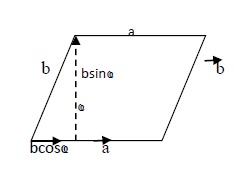Electric Flux Introduction
Description:
So far we have learnt about electric field which is an effect created by a charge around it. We also have learnt about the intensity of electric field which is a vector quantity and it tells us about the force being applied on a charged particle, which is located at any place and the electric field is the characteristic of that location.
In this chapter we will be learning about the electric flux, which is the quantity of electric field and it can be explained by an example.
Assuming that there are two setups of a strong and a week electric fields and in each of these two areas are kept (one small and one large) as shown in figure −

From figure we can see that more electric field lines are passing through the areas placed in strong electric field than the areas placed in weaker electric field.
The quantity of electric field which is linked to a particular plane in the electric field represents electric flux.
Electric Flux − Electric flux is a quantity of electric field linked to an area kept in it. It is a scalar quantity denoted by (Φ)
Comparing Electric flux and Electric field with an example of air.
If air flowing in a particular direction enters the room through a window , then quantity of air entering the room per second will depend on two quantities −
- Velocity or intensity of air.
- Area of the window.
Here, velocity of air is a vector quantity. More the velocity of air, more will be the quantity of air filling the room and if the velocity is less, then less air will enter the room.
Similarly, if the area of open window is more, more air will fill the room and if the area is less, then less air will enter the room.
Here the quantity of air entered the room is called air flux. Which has no direction and hence is a scalar quantity.
Similarly, The quantity of Electric flux depends on two quantities −
- Intensity of electric field
- Area of cross section
Here, Intensity of electric Field is a vector quantity. More the Intensity of electric Field, more will be the number of electric field lines passing through the area and less the Intensity of electric Field, less will be the number of electric field lines passing through the area.
Similarly: Larger the Area of cross section in the electric field, more will be the number of electric field lines passing through the area and smaller the Area of cross section in the electric field, less will be the number of electric field lines passing through the area.
Here the electric field moves in a particular direction, so it is a vector quantity. But as the quantity of electric flux linked with the area in electric field has no direction, so it is a scalar quantity.
Electric flux is given by − Φ = E→ . A→
from fig (A) direction of both electric field and area are parallel to each other so the electric flux will be the dot(.) product of these two.
Electric flux = EA cosθ
⇒ Electric flux = E→ . A→
So, electric flux is a scalar product.
OR
E→ = electric flux / A→
Flux per unit area gives electric field intensity.
Note − Both electric field intensity and area are vector quantities and electric flux is the scalar product of these two quantities.
Direction of area is always perpendicular to the plane.
Direction of area is given by the cross product of length and width.
(A→ = a→ × b→)
Let there is an area as shown in figure. The width of the area can be resolved into two components (bcosθ and bsinθ) as shown in figure −
From figure; length ‘a‘ and ‘bsin θ’ are perpendicular to each other.
So, area A = absin θ. This can also be written as;
A→ = a→ × b→
So, A is always perpendicular to the plane. Direction of A→ is shown in figure.


